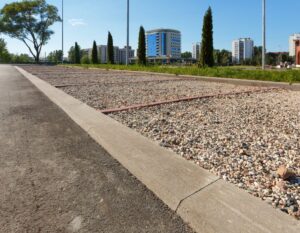
How Paving Choice Impacts Sustainability in Cities
Urban planners and engineers must find ways to improve the sustainability of our concrete jungles as infrastructure continues expanding. The choice of paving material is one crucial aspect they often oversee.
Since this might not be an apparent factor at first glance, understanding how different types of paving materials can impact a city’s overall sustainability is important. Below, we explore how paving choices impact sustainability initiatives in cities and the environment.
Reduction in Urban Heat Island Effect
The type of paving material used greatly influences the heat island effect in urban areas. This phenomenon refers to the increased temperature experienced in cities due to the abundance of paved surfaces that absorb and re-emit heat. For instance, lighter-colored paving materials, such as permeable concrete, can help mitigate this effect since they reflect more sunlight.
Moreover, permeable pavements, like permeable pavers and porous asphalt, allow rainwater to percolate through the surface, which cools the earth near and under our cityscapes. Urban planners can improve the overall comfort and livability of cities while reducing the energy consumption of air-conditioned buildings by choosing such materials.
Better Stormwater Management
Effective stormwater management is essential for preventing flooding, water pollution, and erosion. Permeable paving materials allow water to infiltrate the ground, reducing the burden on drainage systems and decreasing the risk of floods. Green paving options, such as grass pavers, give cities the extra benefit of retaining stormwater, purifying runoff, and replenishing groundwater sources, thus sustaining local ecosystems.
Enhanced Biodiversity and Green Spaces
Living pavements, which incorporate plants and grasses into the design, can bring more green spaces to urban areas. These surfaces improve local biodiversity by providing natural habitats for various flora and fauna, creating a healthier and more vibrant urban environment. These pavements, in turn, enhance the well-being of city dwellers, clean the air, and encourage outdoor activity.
Encouraging Alternative Transportation Options
Paving choice also impacts sustainability in cities by making it easier to partake in less environmentally harmful transportation methods. Sustainability-focused paving choices can promote alternative transportation methods such as cycling and walking.
For example, cycling lanes with specially designed, smooth pavement can encourage more people to ride bikes as a mode of transportation, reducing greenhouse gas emissions and traffic congestion. Additionally, pedestrian-friendly walkways with attractive designs can invite locals and tourists to explore cities on foot.
Improved Lifespan and Lower Maintenance Requirements
Above all, the durability and longevity of paving materials contribute to each city’s overall sustainability. Using materials that last can lead to a lower replacement frequency and reduced need for maintenance. Certain resources can withstand heavy loads, high traffic, and variable weather conditions while maintaining their structural and aesthetic quality. This maintenance leads to reduced resource consumption, lower costs, and less waste generation over time.
The choice of paving material has far-reaching effects on a city’s environmental sustainability and livability. Urban planners can make informed decisions that contribute to a greener and healthier urban environment by taking an eco-conscious approach. As more cities embrace sustainability initiatives, paving choices will play a crucial role in shaping the future of our urban landscapes.